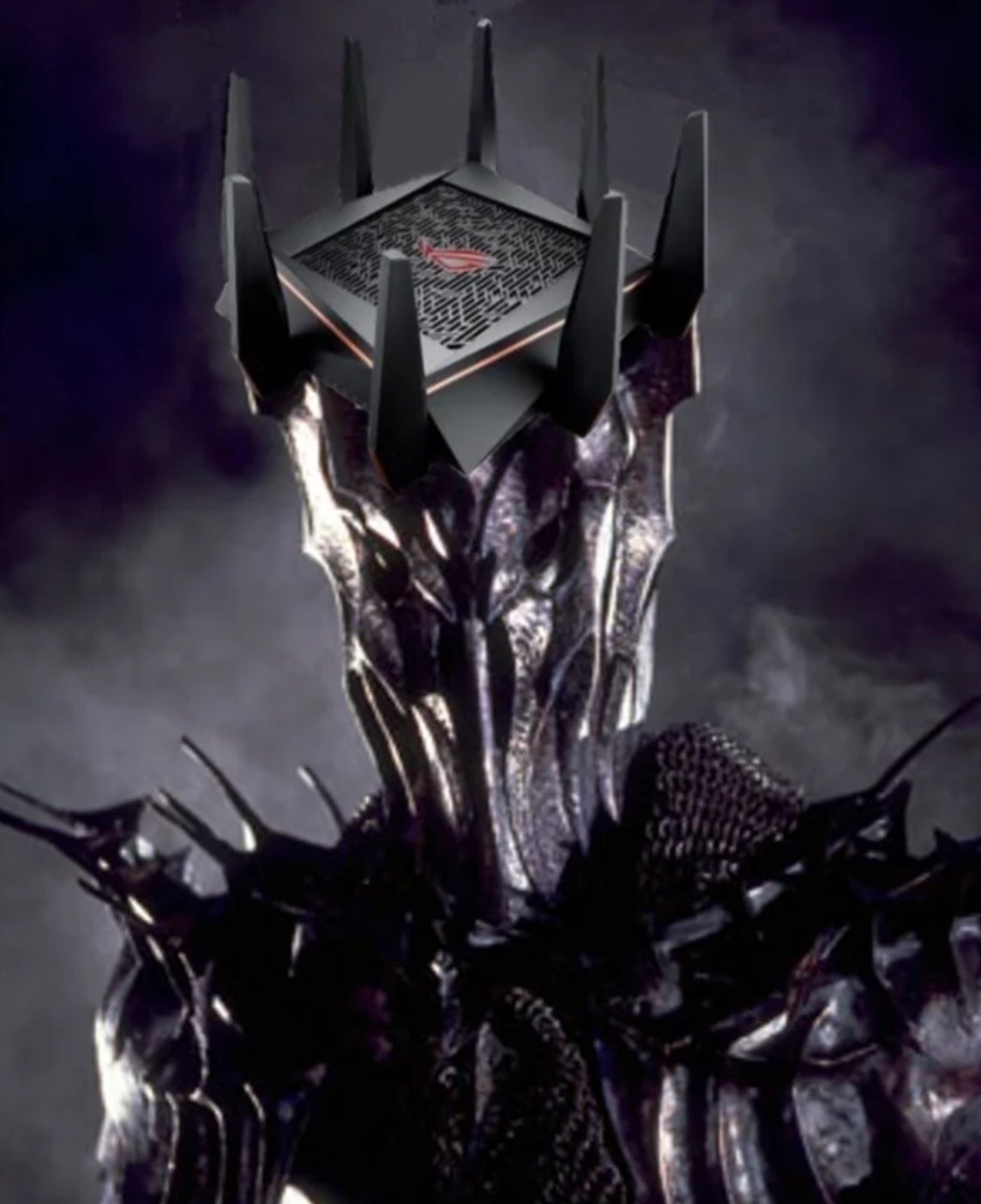Does this ridiculous number of antennas even do anything or is it just marketing wank?
Technically, it does provide better connection speeds by enabling the router to avoid channel hopping, so it can talk to multiple devices (or the same devices if it has multiple antennae) at the same time. This is part of the recent wifi6 and wifi7 standards so more and more devices will start to gain speeds using this technique
Realistically computers have at best 2 antennae and this is largely marketing wank.
Though if you have multiple devices all trying to connect to wifi, like even a phone for example, then a computer having two antenna that it can actually use 100% of the time still sounds valuable to me.
Lord Sauron would like a word.

Some of them are marketing wank, some of them have MIMO channels that need multiple antennas to support independent bands with multiple devices.
1 MIMO channel = 2 antennas, so this router could theoretically have 4 devices communicating bilaterally without interrupting each other.
I believe it’s for beam forming which can be used to improve signal strength in a specific direction.
deleted by creator
Hay $800 worth of copper, I found a 1000ft roll of shielded pure copper for $2.11 because someone misplaced the decimal point I know because it was listed for $2.1199 every thing was automated through amazon so they just shipped free shipping to, thank for listening $800 worth of copper, your the best.
deleted by creator
My PC, laptop, work laptop, are all wired using gigabit. But my laptop on wifi reach 1200Mbps so it’s faster than cable!
Faster than gigabit, but not 2.5 gigabit. Your cables likely support the speed, just your ports and switching hardware are capped at gigabit.
It’s not extremely expensive, but unless you move around a lot of big files, you’re probably getting very diminished returns, even spending less than twice as much for 2.5x speeds.
Impressive, I lose half my speed with the router around the corner.
If you have only one device on Wi-Fi, multiplexing turned off, or especially if you have MU-MIMO support, Wi-Fi can be faster than a single wired connection. It is still higher latency and subject to other drawbacks such as security and power consumption, but of course it offers advantages that can outweigh the disadvantages depending on use case and user needs.
That said, it’s technically not faster than the cable, but rather faster at the data link or network layer. For example, CAT8 physically supports up to 40Gbps, but most consumer and even professional electronics only support up to 2.5Gbps. Only really enterprise level switches can push up to like 100Gbps onto copper, and even then that’s using QSFP transceivers, not RJ-45 connections. Fiber cables regularly push 400Gbps.
Same lol. I get 800Mbps on Cat6, but 1100 on Wifi 6 with one of these fancy expensive 11000ax gaming routers that has all those antennas (antennae?).
Something is wrong there then, because no other ethernet spec is going to cap at 800 Mbps, it’s 10, 100, 1000, 2.5g 5g 10g etc
I know but IDK. Just figured it was an overhead thing. Having a connection that can max out a gigabit ethernet port is still fairly new territory for me.
*Excluding running ethernet cables to every room through the attic, down the walls to wall jacks. Also the cost of the jacks, and the various switches needed for several rooms. And the contractor to do it all.
But hey for like $600 I have cat6a in basically every room so
And then you still need a wireless router to get Internet on your phone unless you use data at home like a crazy person.
But what if you’re gaming downstairs and the router is upstairs and then you have to go upstairs for pizza rolls so you take your gaming laptop upstairs and you’re eating right next to the router and so you’re just plugged in and then what if you forgot to turn off the oven and your girlfriend is yelling at you “You’re going to start a fire! Why can’t you remember to turn off the oven? What’s wrong with you?” and then you go back downstairs to finish gaming?
If that happens often enough to be worth 43 times more than the cat cable, then it sounds totally justified to me. But also, what if you got a toaster oven for upstairs? To put next to the router?
What if you used the router as the toaster oven? Tapping_head.gif
I use the microwave for my pizza rolls like a savage. Problem solved.
I’m seriously thinking of getting a usbC-ethernet dongle for my mobile, for when I’m at my desk.
If you have wireless charging then you should definitely get the dongle. I have one for those times I need stability. Get a thin lightweight USB C extender so the dongle is not getting in the way.
Can you not charge and use a single USB-C port at the same time?
Getting a USB dock instead would probably get you both charging and Ethernet.
I, too, have shitty wireless. In fact, for my work laptop, that’s exactly what I do. So much more reliable. Way too many wireless connections on too many channels close by.
Wireless tech has improved greatly over the last 20 years. Speed, latency, bandwidth, stability…all generally excellent. 15 years ago I wouldn’t have wanted to use a wireless mouse or LAN connection. Now? NBD. They just work. Still have issues with poor signal in some areas, but mesh range boosters take care of that pretty easily.
I spend a lot more money on good Ethernet switches. But at least that works and is easier to manage than Wifi.
Let’s see that ethernet cable do orthogonal frequency-division multiplexing…
Twisted pairs go brrrrrr
Unless you need 6ft of cable or you just run wires on the floor it’s more like $200 of plenium rated cable, and keystone jacks and the labor involved with the run.
My house with a half finished basement (easy access) took probably 16-20 hours running to 5 rooms.
Yeah when i did my house i was quoted $100-200 a drop and that was years ago. I bought materials for 20 drops for about 1k (cables, keystones, plates, cable tester, ethernet cutter, puncher, drywall knife, flex drill bit, wall fishing tape, network switch, and a bunch of other stuff im probably forgetting). It took me 1 hour per drop on average. Some were easy, some were a pain in the ass. Now you can save on materials slightly by doing 1 drop per room whereas i did individual drops for each jack (because i wanted full bandwidth on each line), but either way it is going to end up more costly than an access point or mesh system unless you’re just running one line within the same room.
Definitely worth it if you care about the speed or reliability of your connection but i think for most people these days it’s probably overkill.
If you do go wiring everything then now you’re mostly already set up to do some Power-over-Ethernet (PoE) devices for cameras, access points etc. And next thing you know you’re an amateur home networker!
6.99 is just one cost though. If you’re needing ethernet actually done in walls then you’re going to be paying a lot more than an access point.
Phased arrays are not a joke. You can get ridiculous dynamic range with those
Wireless data links should be the exclusive domain of temporary, nomadic and/or sacrificial applications.
If the channel is permanent, static, or critical; as much of the path as practicable should be provisioned with constrained energy transmission.
Would be cool if building code standards included Cat5 (or even better, USB) along with the standard power and phone connections of new builds.
I have a cat 5 cable running to a wireless access port that is connected to my wireless router. Online I show as having a physical connection, because the last connection to the PC is a plug.
The connection is also pretty solid compared to when I try to use wifi on the same PC to connect to the same wireless access point, which is just over 6 foot away with no obstructions (just checked), or the main router which is in another room.
Seems weird, but it works.
if that’s the latest one that’s a great deal. it’s usually $800.










